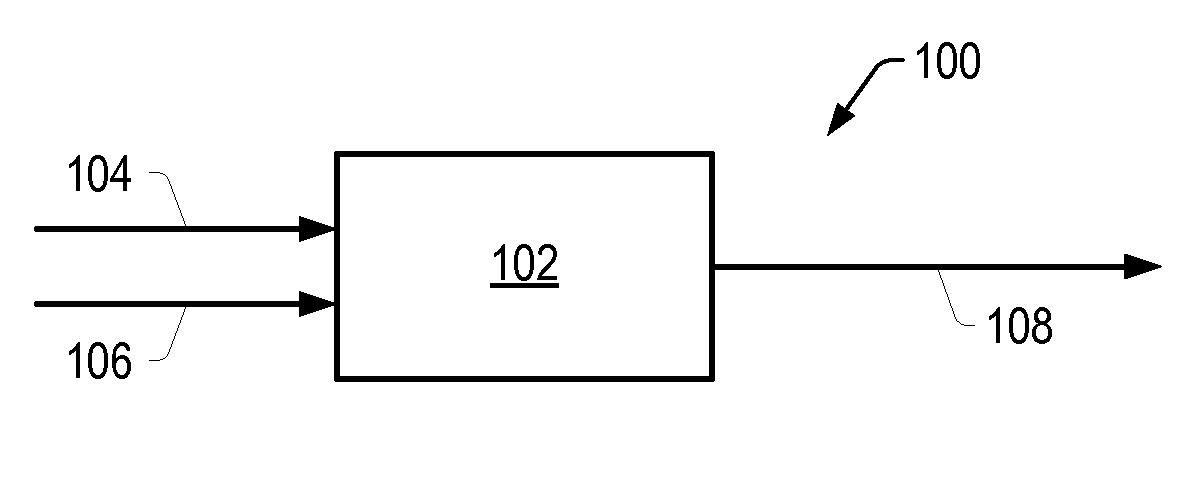Catalysts having selected pore size distributions, method of making such catalysts, methods of producing a crude product, products obtained from such methods, and uses of products obtained
a catalyst and pore size technology, applied in the direction of physical/chemical process catalysts, metal/metal-oxide/metal-hydroxide catalysts, refining with non-metals, etc., can solve the problems of significant amounts of hydrogen, disadvantaged crude undesirable for conventional transportation and/or treatment facilities, and high cost of hydrogen production and/or transportation to treatment facilities. , to achieve the effect of reducing viscosity, high viscosity and low cos
- Summary
- Abstract
- Description
- Claims
- Application Information
AI Technical Summary
Benefits of technology
Problems solved by technology
Method used
Image
Examples
example 1
Preparation of a Columns 6-10 Metal(s) Catalyst
[0184]A first solution was prepared by combining MoO3 (789.96 grams), phosphoric acid (73.66 grams, 85.9 Mol %), and deionized water (2400 grams) to form a slurry. The slurry was heated to 82° C. until dissolution of the solids.
[0185]To the slurry, Ni(OH)2.(210.32 grams) was added at a rate to control any observed exotherm, and then heated to 96° C. until dissolution of the solids. To the heated mixture was added citric acid monohydrate (5 Mol %, 200.46 grams) at a rate sufficient to control any observed exotherm. After addition of the citric acid the solution was heated to 100° C. until the molybdenum / nickel / phosphorus solution was transparent, and then the volume of the molybdenum / nickel / phosphorus solution was reduced to 1249.80 grams.
[0186]To a muller, a support (4076.09 grams) that contained 0.02 grams of silica and 0.98 grams alumina per gram of support was added. With the muller running, the molybdenum / nickel / phosphorus solution ...
example 2
Contact of a Hydrocarbon Feed with a Column 6 Metal(s) Catalyst
[0190]A tubular reactor with a centrally positioned thermowell was equipped with thermocouples to measure temperatures throughout a catalyst bed. The catalyst bed was formed by filling the space between the thermowell and an inner wall of the reactor with catalysts and silicon carbide (20-grid, Stanford Materials; Aliso Viejo, Calif.). Such silicon carbide is believed to have low, if any, catalytic properties under the process conditions described herein. The catalyst was blended with an equal volume amount of silicon carbide before placing the mixture into the contacting zone of the reactor.
[0191]The hydrocarbon feed flow to the reactor was from the top of the reactor to the bottom of the reactor. Silicon carbide was positioned at the bottom of the reactor to serve as a bottom support.
[0192]A Column 6 metal catalyst prepared as described in Example 1 was mixed with silicone carbide (total of 50 cm3) was positioned in th...
example 3
Contact of a Hydrocarbon Feed with a Column 6 Metal(s) Catalyst
[0198]The hydrocarbon feed, catalyst, contacting conditions, and sulfidation were the same as Example 2 except that the pressure during operation (1389 hours) was about 7 MPa. As shown in Table 2, the crude product had a viscosity of 65 cSt at 37.8° C.
[0199]Comparison of the data from Examples 2 and 3 demonstrates that contacting of the hydrocarbon feed at a pressure of 3.5 MPa and at temperatures between 400° C. and 420° C. produces a crude product with enhanced viscosity reduction with less hydrogen consumption was observed as compared to the crude product obtained at higher pressure and the same temperature. Operating at lower pressures provides an economic advantage as less hydrogen is required to operate the contacting system.
PUM
| Property | Measurement | Unit |
|---|---|---|
| temperatures | aaaaa | aaaaa |
| Operating temperatures | aaaaa | aaaaa |
| mercury porosity measurements | aaaaa | aaaaa |
Abstract
Description
Claims
Application Information
 Login to View More
Login to View More - R&D
- Intellectual Property
- Life Sciences
- Materials
- Tech Scout
- Unparalleled Data Quality
- Higher Quality Content
- 60% Fewer Hallucinations
Browse by: Latest US Patents, China's latest patents, Technical Efficacy Thesaurus, Application Domain, Technology Topic, Popular Technical Reports.
© 2025 PatSnap. All rights reserved.Legal|Privacy policy|Modern Slavery Act Transparency Statement|Sitemap|About US| Contact US: help@patsnap.com


